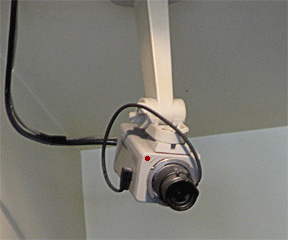 It’s not every day that I get to spend about 45 minutes with an LAPD investigating officer in the conference room of my office. But then again it’s not every day that a man brazenly lies to my staff to gain access to my office to case ‘da joint for a subsequent break-in. Here’s the story…
It’s not every day that I get to spend about 45 minutes with an LAPD investigating officer in the conference room of my office. But then again it’s not every day that a man brazenly lies to my staff to gain access to my office to case ‘da joint for a subsequent break-in. Here’s the story…
This morning, a middle-aged man walked into the reception area of my office. He was wearing a brown uniform (think UPS brown) and a matching cap. The uniform shirt bore a “CAT” (as in the heavy equipment manufacturer) logo and the name of a business.
He was holding a clipboard full of papers.
My receptionist greeted him and asked who he was here to see. He said he was sent from the building office and sent to check our lights.
Our building office is good about building upkeep, and our fluorescent lights do dim, so having someone come up to the suite to check things is not unheard of. Yet the building is pretty good about letting us know about inspections before they occur, so this was unusual.
The gentleman (and I use that term somewhat loosely) walked past my receptionist into the main part of the office…our cubical city…and then he walked into my office.
It’s very unusual for someone…especially a stranger…to walk into my office within the suite without being announced in advance and escorted back, so my feathers came up.
I stood up and came around my desk to greet the man.
I asked what he was here for, and he mumbled something about the lights. The uniform certainly didn’t suggest he was from a lighting company, so I asked him for his work order. He mumbled something about his boss sending him, and that the boss was on the building roof. Because of where my office is located on the third floor of this office building, I usually hear workers accessing the roof just above.
I hadn’t heard anything today. My back feathers were starting to stand on edge.
I asked the man for ID, but he said he had none.
“Step out of my office NOW.” He backed up.
Using the not-inconsiderable bulk of my body, I corralled him back and back and back into the front reception area. Then I turned to a staff member and told her to immediately call the building office to determine whether this person was, as claimed, sent by the building management.
The man turned and started moving towards the front door of the office suite. I trailed, yelling to staff to make the call to the building office NOW.
He opened the front door of the suite. By the time his body was through that portal, he was at a full trot. By the time he turned the corner to the stairwell (apparently not wanting to wait for the elevator!) he was in a full gallop.
What he didn’t expect to find were that the stairs down to the ground level are blocked off on my floor by a construction barrier. This is due to construction work on the second floor landing. Not deterred, and not wanting to stick around to have a thoughtful discussion regarding his predicament, he chose to hop the construction barrier at the third floor stairs.
My visitor was in for a really big surprise.
Upon reaching the second floor landing, he found himself blocked from proceeding in any direction except back up into my, ah, waiting arms. Considering his lack of options, he decided to jumped over the railing and fall about 15 feet to the first floor below. He fell feet first.
How do I know his flight by air, since I didn’t see it? (I did hear some very interesting crunching and banging sounds, though.)
Our building has an extensive system of security cameras on each floor, and at each building entrance. One of the cameras captured him entering the frame from above, feet first, and landing none-to-gracefully on the cement of the first floor. A moment after his stunning landing, he recovered his wits sufficiently to get up and run/limp away to the waiting getaway vehicle, an SUV.
After the Burglar (let’s call him by his proper title) fled, I immediately went to the building office. They were already alerted to what was up by my office’s call, and another tenant in the building. It was a pleasure to see his face so clearly on the security camera recordings. I would learn that other building security cameras followed him from the moment he entered the building to the time he flew the coop. He’s the star of his own reality video, now!
The building manager called the LAPD, and now you know why I sent 45 minutes with an LAPD investigating officer today.
Once cleared by the LAPD, I’ll see about posting the video of this ne’er-do-well falling 15 feet, feet first, on to his posterior. It’s quite the sight to behold.
